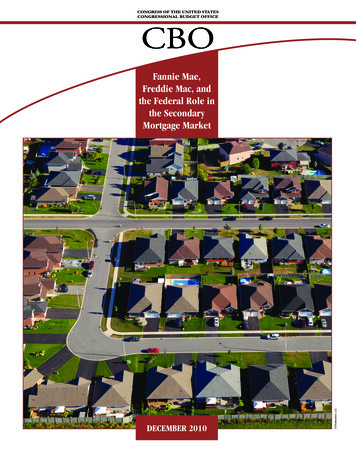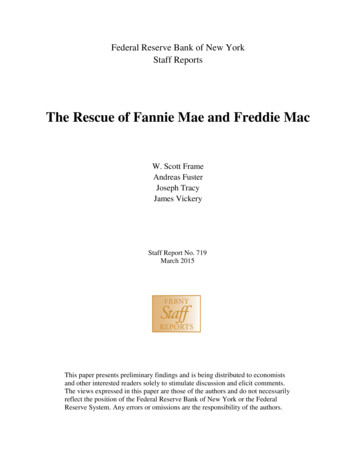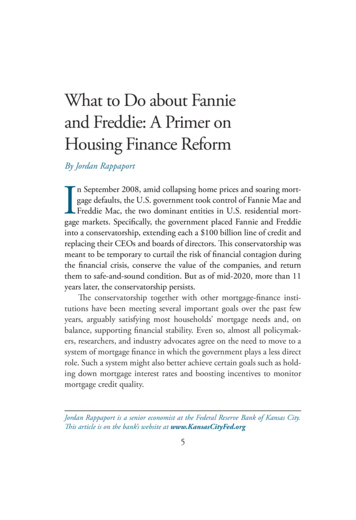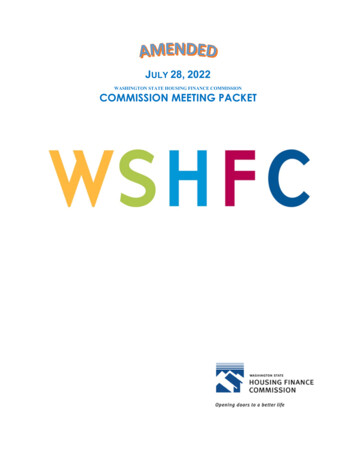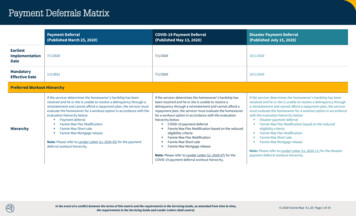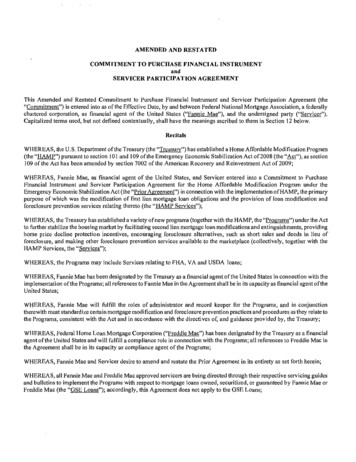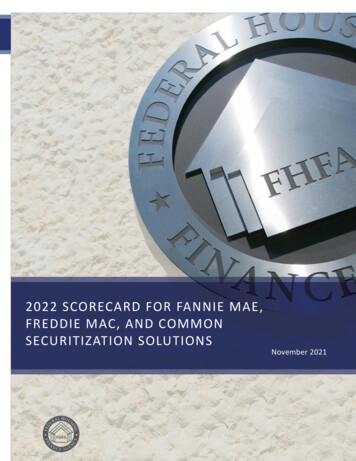
Transcription
2022 Scorecard2022 SCORECARD FOR FANNIE MAE,FREDDIE MAC, AND COMMONSECURITIZATION SOLUTIONSPage FooterNovember 2021
2022 Scorecard2022 SCORECARD FOR FANNIE MAE, FREDDIE MAC, ANDCOMMON SECURITIZATION SOLUTIONSFor all Scorecard items, Fannie Mae and Freddie Mac (the Enterprises) and CommonSecuritization Solutions, LLC (CSS) will be assessed based on the following criteria:Assessment Criteria Each Enterprise’s products and programs foster sustainable and equitable housing financemarkets that support safe, decent, and affordable homeownership and rentalopportunities.Each Enterprise conducts business in a safe and sound manner.Each Enterprise meets expectations under all FHFA requirements, including thosepertaining to capital, liquidity, and credit risk transfer.Each Enterprise continues to manage operations while in conservatorship in a mannerthat preserves and conserves assets through the prudent stewardship of Enterpriseresources.Each Enterprise cooperates and collaborates with FHFA to meet the Conservator’spriorities, directives, and guidance throughout the course of the year.Each Enterprise delivers work products that are high quality, thorough, creative,effective, and timely, and that consider effects on borrowers and renters, the Enterprises,the industry, and other stakeholders.Each Enterprise ensures that diversity, equity, and inclusion remain top priorities instrategic planning, operations, and business development.2
2022 ScorecardPromote Sustainable and Equitable Access to Affordable Housing (50%)Conduct business and undertake initiatives that support affordable, sustainable, and equitableaccess to homeownership and rental housing, and fulfill all statutory mandates.Take significant actions to ensure that all borrowers and renters have equitable access tolong-term affordable housing opportunities Develop strategies to support sustainable homeownership and affordable rental housing.o Improve availability of small-balance purchase and refinance mortgages. Develop high-quality Equitable Housing Finance Plans and take meaningful actions toachieve the goals and objectives of the plans. Meet Housing Goals and Duty-to-Serve requirements. Identify strategies and activities to facilitate greater affordable housing supply within thelimits of charter authorities and submit recommendations to FHFA. Update the current pricing framework to increase support for core mission borrowers,while ensuring a level playing field for small and large sellers, fostering capitalaccumulation, and achieving viable returns on capital. Continue mortgage selling, servicing, and asset management efforts that promotesustainable home-retention solutions for borrowers affected by the COVID-19 pandemic.Foster competition and efficiency in housing finance markets Modernize the single-family appraisal process to foster efficiency in mortgage markets,and address barriers to equitable valuation. Complete the final phase of validation and approval of credit score models and beginplanning for implementation. Leverage technology and data to further promote efficiency and cost savings in mortgageprocesses. Research and assess opportunities to increase access for small and regional lenders toEnterprise multifamily products.Manage new multifamily purchases to remain within the multifamily cap requirementsdescribed in Appendix A, including expanded affordability requirements.3
2022 ScorecardOperate the Business in a Safe and Sound Manner (50%)Operate with heightened focus on safety and soundness and with a prudent risk profileconsistent with continued support for housing finance markets throughout the economic cycle,while minimizing the risk of requiring a draw against the Treasury commitment in stressedscenarios.Ensure that the Enterprise is resilient to operational, market, credit, economic, and climaterisks. Address examination and supervision findings promptly. Maintain liquidity at levels required by FHFA and sufficient to sustain Enterpriseoperations through severe stress events. Maintain effective risk management systems appropriate for entities that need tominimize risk to capital as they rebuild their capital buffers. Ensure a governance structure exists to prioritize the effects of climate change throughoutEnterprise decision making. Continue to ensure a successful transition away from LIBOR to approved alternativereference rates by continuing systems development and announcing plans for thetransition of legacy products.Transfer a significant amount of credit risk to private investors, reducing risk to taxpayers.Ensure CSS operates in a safe and sound manner in support of Enterprise securitizationactivities.4
2022 ScorecardAPPENDIX A: MULTIFAMILY DEFINITIONS1. Market share target and review of market sizeThe 2022 Scorecard establishes a 78 billion cap on the multifamily purchase volume of eachEnterprise, for a total of 156 billion and applicable for calendar year 2022. Within this cap,certain loans in affordable and underserved market segments are considered “missiondriven.” The 2022 Scorecard requires that a minimum of 50 percent of Enterprisemultifamily loan purchases be mission-driven in accordance with the definitions herein.Furthermore, the 2022 Scorecard requires that a minimum of 25 percent of Enterprisemultifamily loan purchases be affordable to residents at 60 percent of area median income(AMI) or below. Loan purchases that meet the minimum 25 percent requirement may alsocount as loan purchases that meet the minimum 50 percent requirement. FHFA anticipatesthe 78 billion cap to be appropriate given current market forecasts; however, FHFA willcontinue to review its estimates of market size and mission-driven minimum requirementsthroughout the year. To prevent market disruption, if FHFA determines that the actual size ofthe 2022 market is smaller than was initially projected, FHFA will not reduce the caps.The following sections explain how FHFA will treat mission-driven loans for purposes of the2022 Scorecard.2. Loans on targeted affordable housing propertiesTargeted affordable housing loans are loans to properties encumbered by a regulatoryagreement or a recorded use restriction under which all or a portion of the units are restrictedfor occupancy by tenants with limited incomes and which restrict the rents that can becharged for those units. FHFA will classify as mission-driven a proportionate amount of theloan for properties in the targeted affordable category, depending on the percentage of unitsthat are restricted by a regulatory agreement or recorded use restriction. FHFA will classifyas mission-driven 50 percent of the loan amount if the percentage of restricted units is lessthan 50 percent of the total units in a project, and 100 percent of the loan amount if thepercentage of restricted units is equal to or more than 50 percent.The following are examples of loans on targeted affordable housing properties that FHFAwill classify as mission-driven: Loans on properties subsidized by the Low Income Housing Tax Credit (LIHTC)program, which limits tenant incomes at 60 percent of AMI or below;5
2022 Scorecard Loans on properties developed under state or local inclusionary zoning, real estate taxabatement, loan or similar programs, where the property owner has agreed to: a) restrict aportion of the units for occupancy by tenants with limited incomes in accordance with therequirements of the state or local program and restrict the rents that can be charged forthose units at rents affordable to those tenants; and b) enforce these restrictions through aregulatory agreement or recorded use restriction; Loans on properties covered by a Section 8 Housing Assistance Payment contract wherethe contract limits tenant incomes to 80 percent of AMI or below. FHFA will notconsider a unit that is occupied by a Section 8 certificate or voucher holder as a targetedaffordable housing unit unless there is also a contract, a regulatory agreement, or arecorded use restriction; and Loans on properties where a Public Housing Authority (PHA), or a nonprofitdevelopment affiliate of a PHA, is the borrower, and where the regulatory agreement orrecorded use restriction restricts all or a portion of the units for occupancy by tenantswith limited incomes and/or restricts the rents that can be charged for those units.On a case-by-case basis, FHFA will consider Enterprise requests to classify other loans asmission-driven that meet affordable housing and mission goals but do not meet the exactdefinition of targeted affordable housing. Requests may be submitted for consideration onlyafter meeting with FHFA to discuss the request. FHFA will not consider Enterprise requestson loans where affordability is predicated on borrower-initiated (or voluntary) rentrestrictions.3. Loans on other affordable unitsFHFA will classify as mission-driven units whose rents are affordable to tenants at variousincome thresholds but that are not subject to a regulatory agreement or recorded userestriction. FHFA will count as mission-driven, the pro rata portion of the loan amount basedon the percentage of units with affordable, unsubsidized/market rents, as described below.a. Loans on affordable units in standard marketsStandard markets are those that are not located in rural areas or in designated costburdened or very cost-burdened renter markets. For properties located in thesemarkets, the income threshold for affordability is 80 percent of AMI or below.b. Loans on affordable units in cost-burdened or very cost-burdened renter markets6
2022 ScorecardIn cost-burdened renter markets as designated by FHFA, the income threshold foraffordability is 100 percent of AMI or below. In very cost-burdened renter markets asdesignated by FHFA, the income threshold for affordability is 120 percent of AMI orbelow.4. Loans on properties located in rural areasRural areas are those areas designated as such in the Duty to Serve regulation. FHFA willclassify as mission-driven, the pro rata portion of the loan amount based on the percentage ofunits affordable at 100 percent of AMI or below.5. Loans on small multifamily propertiesSmall multifamily properties are properties that have 5 to 50 units. FHFA will classify asmission-driven, the pro rata portion of the loan amount based on the percentage of unitsaffordable at 80 percent of AMI or below in standard renter markets, 100 percent of AMI orbelow in cost-burdened renter markets, and 120 percent of AMI or below in very costburdened renter markets.6. Manufactured housing community blanket loansLoans to manufactured housing communities are blanket loans secured by the land and therental pads. FHFA will classify as mission-driven the share of the loan amount of amanufactured housing community blanket loan that reflects the share of units that receivescredit under the Duty to Serve regulation.FHFA strongly encourages the adoption of tenant pad lease protections that meet or exceedthose listed in the Duty to Serve regulation in all manufactured housing communities.7. Loans on seniors housing assisted living propertiesFor loans on seniors housing assisted living properties, FHFA will classify as mission-driven,the pro rata portion of the loan amount based on the percentage of units affordable at 80percent of AMI or below.8. Loans to finance energy or water efficiency improvements7
2022 ScorecardLoans to finance energy or water efficiency improvements are loans funded by theEnterprises under their own specialized financing programs for this purpose. For loans underthe Fannie Mae Green Rewards and Freddie Mac Green Up and Green Up Plus loanprograms, 50 percent of the loan amount will be classified as mission-driven if at least 20percent but less than 50 percent of the unit rents are affordable at or below 60 percent ofAMI, and 100 percent of the loan amount if the percentage of affordable units is equal to ormore than 50 percent.The renovations under the program (including subsequent program enhancements, asapproved by FHFA) must project a minimum 15 percent reduction in annual whole propertyenergy consumption and a minimum 15 percent reduction in annual whole property waterand/or energy consumption. (Thus, a property projecting 30 percent energy consumptionreduction would qualify for mission-driven credit, as would a property projecting 15 percentenergy and 15 percent water consumption reduction, or 20 percent energy and 10 percentwater consumption reduction.)In addition, prior to Enterprise purchase, all Fannie Mae Green Rewards and Freddie MacGreen Up and Green Up Plus transactions must have a third-party data collection firmengaged for ongoing data collection for the life of the loan, in order to receive mission-drivencredit. This third-party firm can be funded by the borrower, the lender, or the Enterprise.FHFA will require specific data elements on all transactions where energy or waterefficiency improvements are made for both Enterprises to determine the effectiveness of theprograms in achieving policy outcomes, on an annual basis.For loans funded under the Fannie Mae Green Building Certification program or the FreddieMac Green Certified program, FHFA will classify as mission-driven 50 percent of the loanamount if at least 20 percent but less than 50 percent of the unit rents are affordable at orbelow 60 percent of AMI, and classify 100 percent of the loan amount if the percentage ofaffordable units is equal to or more than 50 percent.9. Other Scorecard requirementsFor purposes of reporting on loan and commitment activity under the 2022 caps, theEnterprises must: a) use the definitions for determining unit affordability of seniors housingassisted living units, coop units, and shared living arrangements, including student housing,that are included in the housing goals regulation at 12 CFR 1282.1; b) use affordability dataas of the loan acquisition date; c) report monthly to FHFA on their acquisition andcommitment volumes using a reporting format defined by FHFA; and d) report quarterly ontheir acquisition volumes under the caps including detail on mission-driven loan purchasesusing a reporting format to be determined by FHFA.8
driven." The 2022 Scorecard requires that a minimum of 50 percent of Enterprise multifamily loan purchases be mission-driven in accordance with the definitions herein. Furthermore, the 2022 Scorecard requires that a minimum of 25 percent of Enterprise multifamily loan purchases be affordable to residents at 60 percent of area median income

